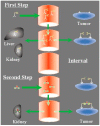Tumor immunotargeting using innovative radionuclides
- PMID: 25679452
- PMCID: PMC4346935
- DOI: 10.3390/ijms16023932
Tumor immunotargeting using innovative radionuclides
Abstract
This paper reviews some aspects and recent developments in the use of antibodies to target radionuclides for tumor imaging and therapy. While radiolabeled antibodies have been considered for many years in this context, only a few have reached the level of routine clinical use. However, alternative radionuclides, with more appropriate physical properties, such as lutetium-177 or copper-67, as well as alpha-emitting radionuclides, including astatine-211, bismuth-213, actinium-225, and others are currently reviving hopes in cancer treatments, both in hematological diseases and solid tumors. At the same time, PET imaging, with short-lived radionuclides, such as gallium-68, fluorine-18 or copper-64, or long half-life ones, particularly iodine-124 and zirconium-89 now offers new perspectives in immuno-specific phenotype tumor imaging. New antibody analogues and pretargeting strategies have also considerably improved the performances of tumor immunotargeting and completely renewed the interest in these approaches for imaging and therapy by providing theranostics, companion diagnostics and news tools to make personalized medicine a reality.
Figures




References
-
- Goldenberg D.M., de Land F., Kim E., Bennett S., Primus F.J., van Nagell J.R., Estes N., de Simone P., Rayburn P. Use of Radiolabeled Antibodies to Carcinoembryonic Antigen for the Detection and Localization of Diverse Cancers by External Photoscanning. N. Engl. J. Med. 1978;298:1384–1386. doi: 10.1056/NEJM197806222982503. - DOI - PubMed
-
- Khaw B.A., Cooney J., Edgington T., Strauss H.W. Differences in Experimental Tumor Localization of Dual-Labeled Monoclonal Antibody. J. Nucl. Med. 1986;27:1293–1299. - PubMed
Publication types
MeSH terms
Substances
LinkOut - more resources
Full Text Sources
Other Literature Sources

